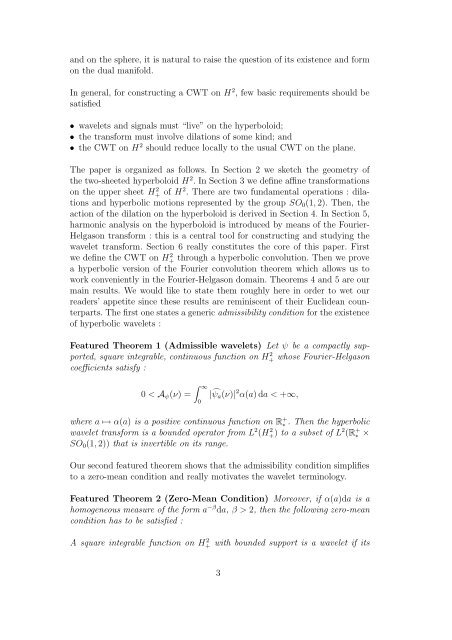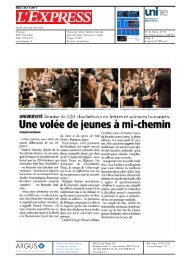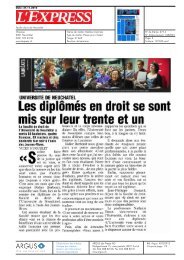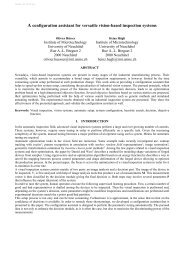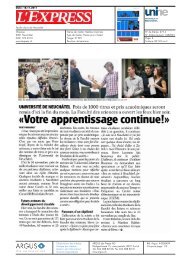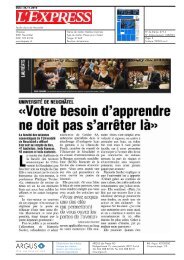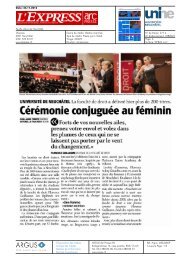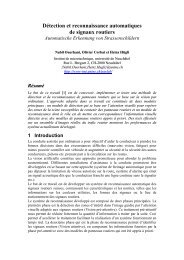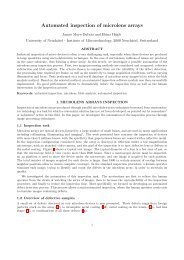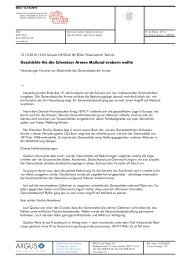Continuous Wavelet Transform on the Hyperboloid - Université de ...
Continuous Wavelet Transform on the Hyperboloid - Université de ...
Continuous Wavelet Transform on the Hyperboloid - Université de ...
Create successful ePaper yourself
Turn your PDF publications into a flip-book with our unique Google optimized e-Paper software.
and <strong>on</strong> <strong>the</strong> sphere, it is natural to raise <strong>the</strong> questi<strong>on</strong> of its existence and form<br />
<strong>on</strong> <strong>the</strong> dual manifold.<br />
In general, for c<strong>on</strong>structing a CWT <strong>on</strong> H 2 , few basic requirements should be<br />
satisfied<br />
• wavelets and signals must “live” <strong>on</strong> <strong>the</strong> hyperboloid;<br />
• <strong>the</strong> transform must involve dilati<strong>on</strong>s of some kind; and<br />
• <strong>the</strong> CWT <strong>on</strong> H 2 should reduce locally to <strong>the</strong> usual CWT <strong>on</strong> <strong>the</strong> plane.<br />
The paper is organized as follows. In Secti<strong>on</strong> 2 we sketch <strong>the</strong> geometry of<br />
<strong>the</strong> two-sheeted hyperboloid H 2 . In Secti<strong>on</strong> 3 we <strong>de</strong>fine affine transformati<strong>on</strong>s<br />
<strong>on</strong> <strong>the</strong> upper sheet H+ 2 of H2 . There are two fundamental operati<strong>on</strong>s : dilati<strong>on</strong>s<br />
and hyperbolic moti<strong>on</strong>s represented by <strong>the</strong> group SO 0 (1, 2). Then, <strong>the</strong><br />
acti<strong>on</strong> of <strong>the</strong> dilati<strong>on</strong> <strong>on</strong> <strong>the</strong> hyperboloid is <strong>de</strong>rived in Secti<strong>on</strong> 4. In Secti<strong>on</strong> 5,<br />
harm<strong>on</strong>ic analysis <strong>on</strong> <strong>the</strong> hyperboloid is introduced by means of <strong>the</strong> Fourier-<br />
Helgas<strong>on</strong> transform : this is a central tool for c<strong>on</strong>structing and studying <strong>the</strong><br />
wavelet transform. Secti<strong>on</strong> 6 really c<strong>on</strong>stitutes <strong>the</strong> core of this paper. First<br />
we <strong>de</strong>fine <strong>the</strong> CWT <strong>on</strong> H+ 2 through a hyperbolic c<strong>on</strong>voluti<strong>on</strong>. Then we prove<br />
a hyperbolic versi<strong>on</strong> of <strong>the</strong> Fourier c<strong>on</strong>voluti<strong>on</strong> <strong>the</strong>orem which allows us to<br />
work c<strong>on</strong>veniently in <strong>the</strong> Fourier-Helgas<strong>on</strong> domain. Theorems 4 and 5 are our<br />
main results. We would like to state <strong>the</strong>m roughly here in or<strong>de</strong>r to wet our<br />
rea<strong>de</strong>rs’ appetite since <strong>the</strong>se results are reminiscent of <strong>the</strong>ir Eucli<strong>de</strong>an counterparts.<br />
The first <strong>on</strong>e states a generic admissibility c<strong>on</strong>diti<strong>on</strong> for <strong>the</strong> existence<br />
of hyperbolic wavelets :<br />
Featured Theorem 1 (Admissible wavelets) Let ψ be a compactly supported,<br />
square integrable, c<strong>on</strong>tinuous functi<strong>on</strong> <strong>on</strong> H+ 2 whose Fourier-Helgas<strong>on</strong><br />
coefficients satisfy :<br />
0 < A ψ (ν) =<br />
∫ ∞<br />
0<br />
| ̂ψ a (ν)| 2 α(a)da2, <strong>the</strong>n <strong>the</strong> following zero-mean<br />
c<strong>on</strong>diti<strong>on</strong> has to be satisfied :<br />
A square integrable functi<strong>on</strong> <strong>on</strong> H 2 + with boun<strong>de</strong>d support is a wavelet if its<br />
3


